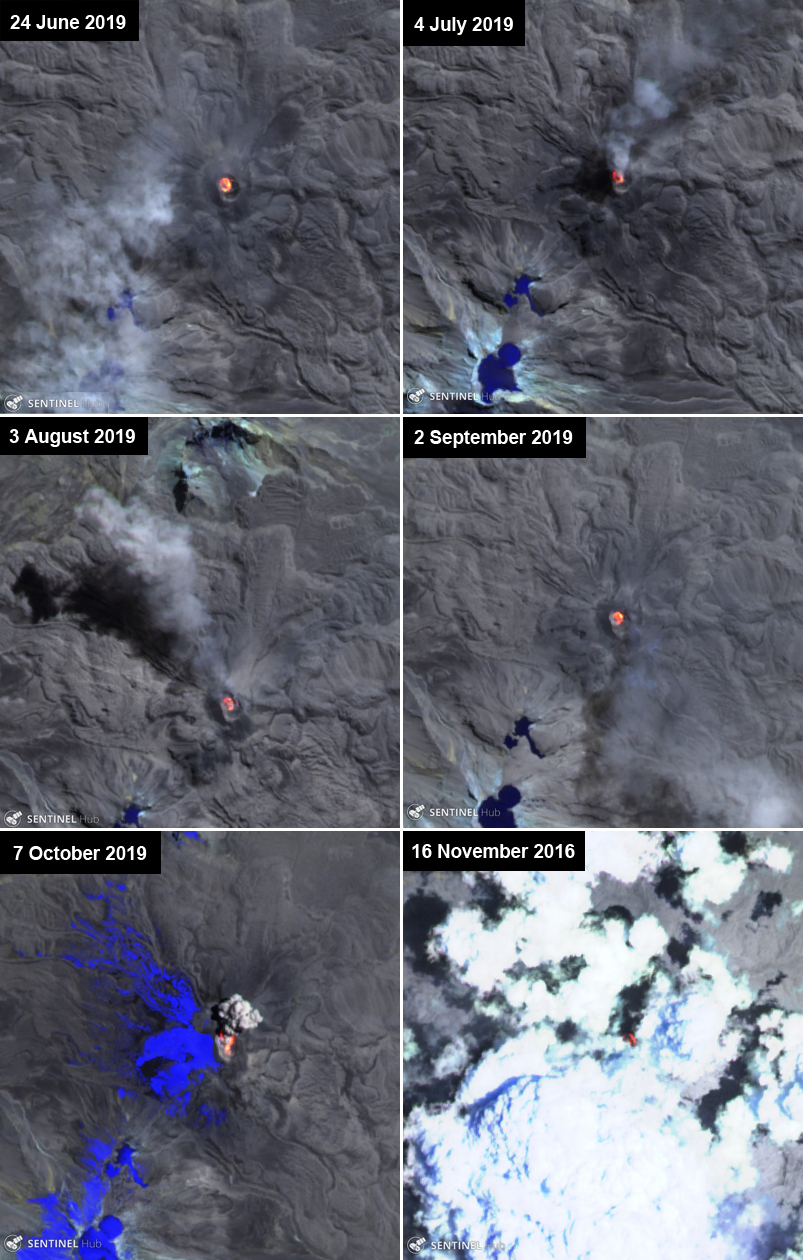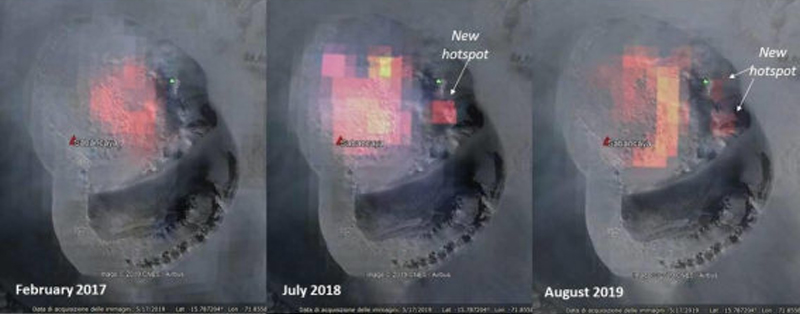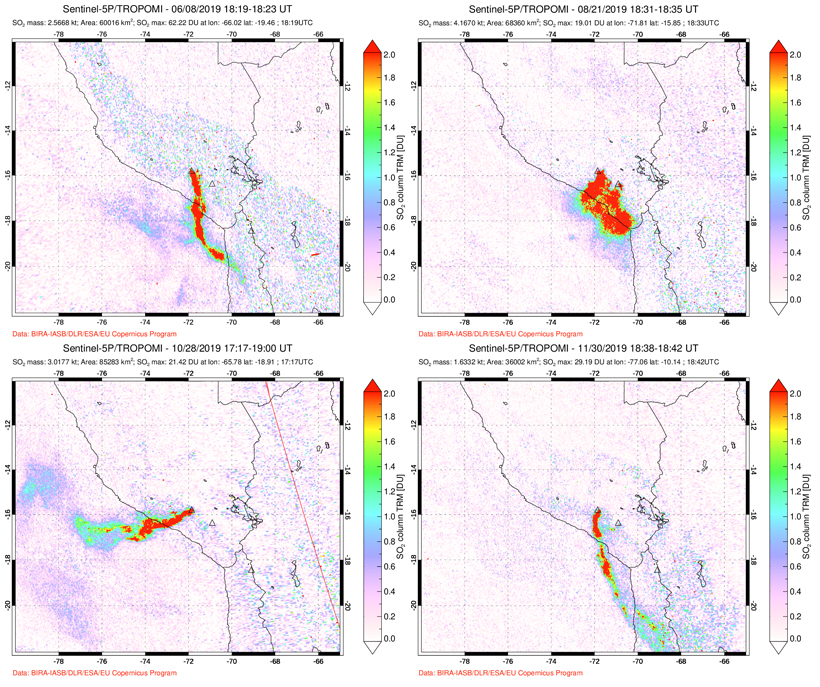Report on Sabancaya (Peru) — December 2019
Bulletin of the Global Volcanism Network, vol. 44, no. 12 (December 2019)
Managing Editor: Edward Venzke.
Edited by Kadie L. Bennis.
Sabancaya (Peru) Explosions, ash and SO2 plumes, thermal anomalies, and lava dome growth during June-November 2019
Please cite this report as:
Global Volcanism Program, 2019. Report on Sabancaya (Peru) (Bennis, K.L., and Venzke, E., eds.). Bulletin of the Global Volcanism Network, 44:12. Smithsonian Institution. https://doi.org/10.5479/si.GVP.BGVN201912-354006
Sabancaya
Peru
15.787°S, 71.857°W; summit elev. 5960 m
All times are local (unless otherwise noted)
Sabancaya is an andesitic stratovolcano located in Peru. The most recent eruptive episode began in early November 2016, which is characterized by gas-and-steam and ash emissions, seismicity, and explosive events (BGVN 44:06). The ash plumes are dispersed by wind with a typical radius of 30 km, which occasionally results in ashfall. Current volcanism includes high seismicity, gas-and-steam emissions, ash and SO2 plumes, numerous thermal anomalies, and explosive events. This report updates information from June through November 2019 using information primarily from the Instituto Geofisico del Peru (IGP) and Observatorio Volcanologico del INGEMMET (Instituto Geológical Minero y Metalúrgico) (OVI-INGEMMET).
Table 5. Summary of eruptive activity at Sabancaya during June-November 2019 based on IGP weekly reports, the Buenos Aires VAAC advisories, the HIGP MODVOLC hotspot monitoring algorithm, and Sentinel-5P/TROPOMI satellite data.
| Month | Avg. Daily Explosions by week | Max plume Heights (km above crater) | Plume drift | MODVOLC Alerts | Min Days with SO2 over 2 DU |
| Jun 2019 | 12, 13, 16, 17 | 2.6-3.8 | 30 km S, SW, E, SE, NW, NE | 15 | 20 |
| Jul 2019 | 23, 22, 16, 13 | 2.3-3.7 | E, SE, S, NE | 7 | 25 |
| Aug 2019 | 12, 30, 25, 26 | 2-4.5 | 30 km NW, W S, NE, SE, SW | 7 | 25 |
| Sep 2019 | 29, 32, 24, 15 | 1.5-2.5 | S, SE, E, W, NW, SW | 14 | 26 |
| Oct 2019 | 32, 36, 44, 48, 28 | 2.5-3.5 | S, SE, SW, W | 11 | 25 |
| Nov 2019 | 58, 50, 47, 17 | 2-4 | W, SW, S, NE, E | 13 | 22 |
Explosions, ash emissions, thermal signatures, and high concentrations of SO2 were reported each week during June-November 2019 by IGP, the Buenos Aires Volcanic Ash Advisory Centre (VAAC), HIGP MODVOLC, and Sentinel-2 and Sentinel-5P/TROPOMI satellite data (table 5). Thermal anomalies were visible in the summit crater, even in the presence of meteoric clouds and ash plumes were occasionally visible rising from the summit in clear weather (figure 68). The maximum plume height reached 4.5 km above the crater drifting NW, W, and S the week of 29 July-4 August, according to IGP who used surveillance cameras to visually monitor the plume (figure 69). This ash plume had a radius of 30 km, which resulted in ashfall in Colca (NW) and Huambo (W). On 27 July the SO2 levels reached a high of 12,814 tons/day, according to INGEMMET. An average of 58 daily explosions occurred in early November, which is the largest average of this reporting period.
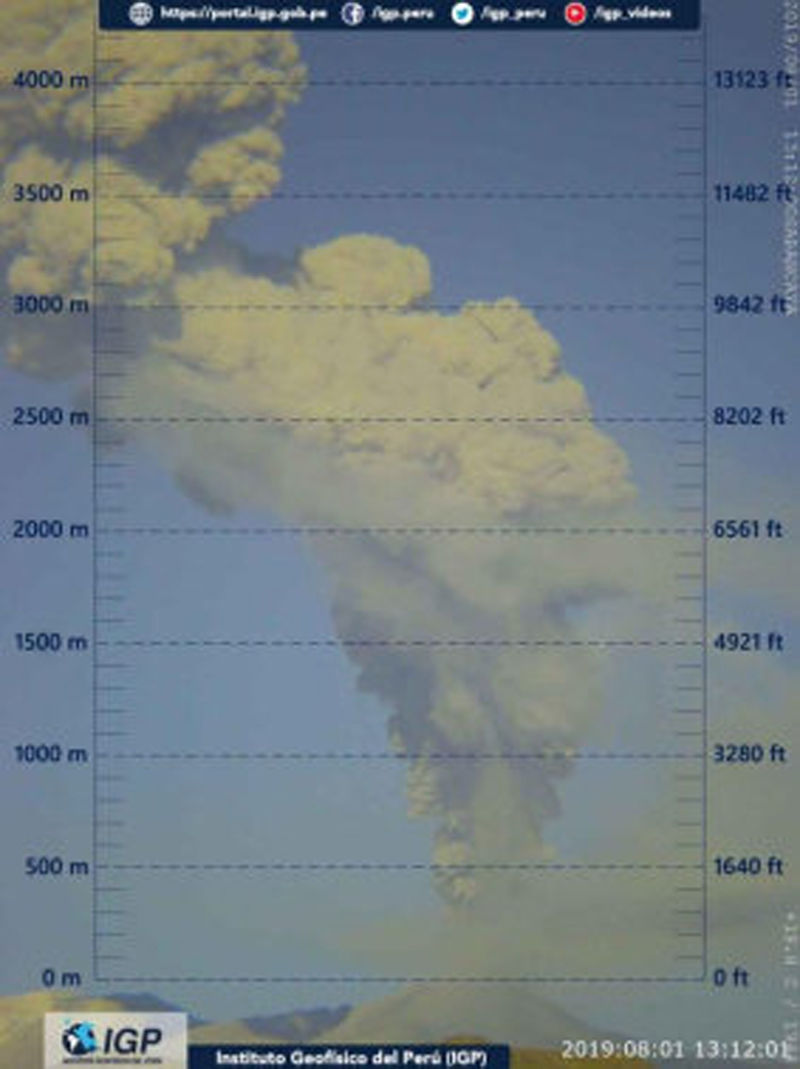 |
Figure 69. A webcam image of an ash plume rising from Sabancaya on 1 August 2019 at least 4 km above the crater. Courtesy of IGP. |
Seismicity was also particularly high between August and September 2019, according to INGEMMET. On 14 August, roughly 850 earthquakes were detected. There were 280 earthquakes reported on 15 September, located 6 km NE of the crater. Both seismic events were characterized as seismic swarms. Seismicity decreased afterward but continued through the reporting period.
In February 2017, a lava dome was established inside the crater. Since then, it has been growing slowly, filling the N area of the crater and producing thermal anomalies. On 26 October 2019, OVI-INGEMMET conducted a drone overflight and captured video of the lava dome (figure 70). According to IGP, this lava dome is approximately 4.6 million cubic meters with a growth rate of 0.05 m3/s.
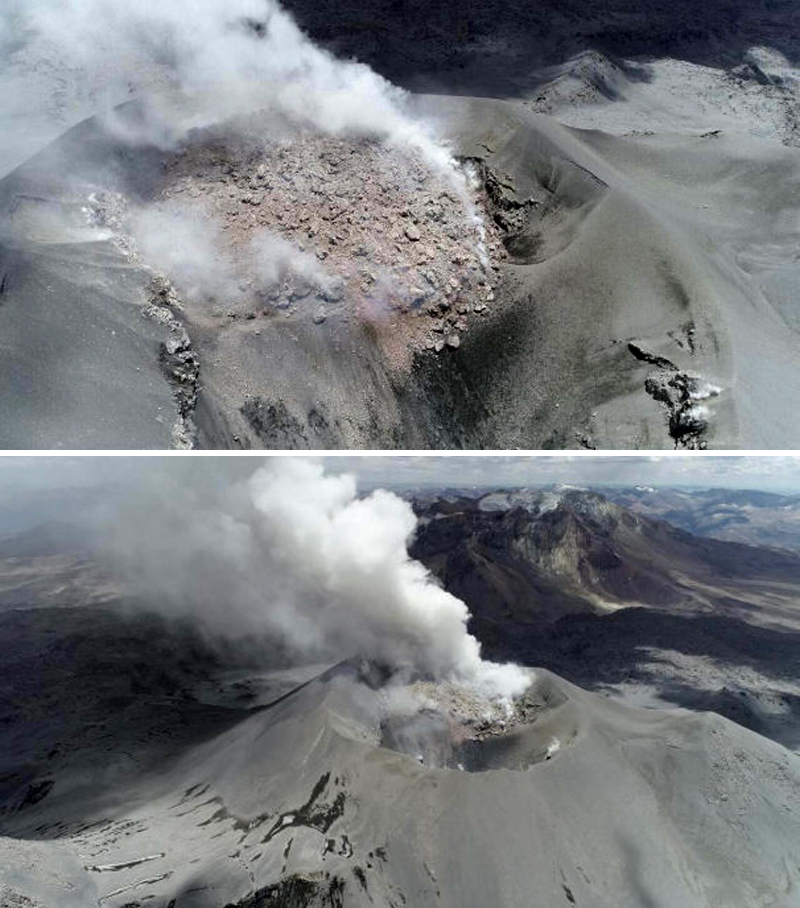 |
Figure 70. Drone images of the lava dome and degassing inside the crater at Sabancaya on 26 (top) and 27 (bottom) October 2019. Courtesy of INGEMMET (Informe Ténico No A6969). |
MIROVA (Middle InfraRed Observation of Volcanic Activity) analysis of MODIS satellite data shows strong, consistent thermal anomalies occurring all throughout June through November 2019 (figure 71). In conjunction with these thermal anomalies, the October 2019 special issue report by INGEMMET showed new hotspots forming along the crater rim in July 2018 and August 2019 (figure 72).
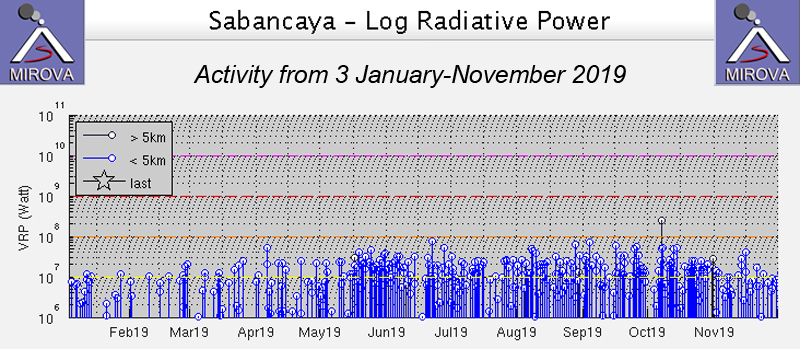 |
Figure 71. Thermal anomalies at Sabancaya for 3 January through November 2019 as recorded by the MIROVA system (Log Radiative Power) were frequent, strong, and consistent. Courtesy of MIROVA. |
Sulfur dioxide emissions also persisted at significant levels from June through November 2019, as detected by Sentinel-5P/TROPOMI satellite data (figure 73). The satellite measurements of the SO2 emissions exceeded 2 DU (Dobson Units) at least 20 days each month during this time. These SO2 plumes sometimes occurred for multiple consecutive days (figure 74).
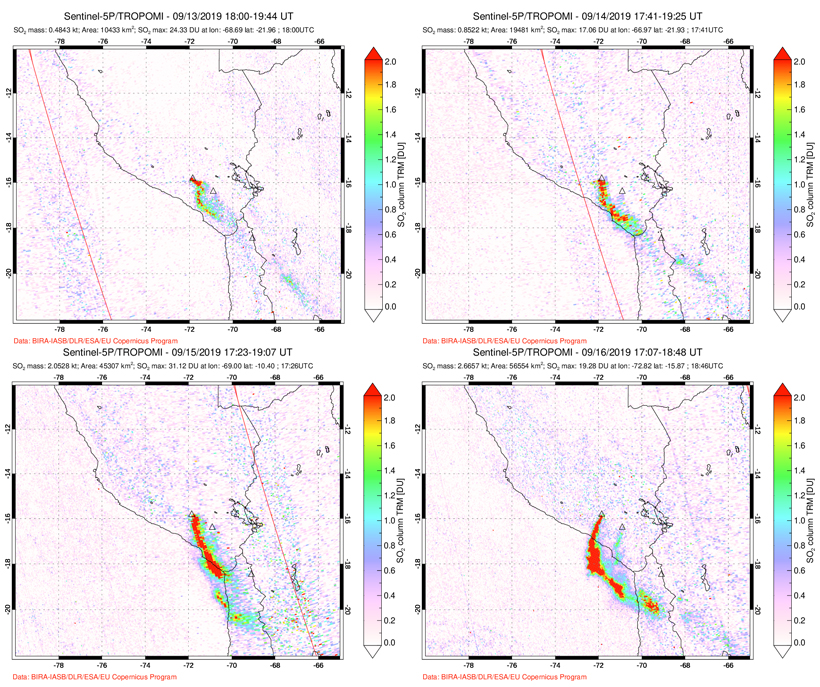 |
Figure 74. Persistent SO2 plumes from Sabancaya appeared daily during 13-16 September 2019 in the TROPOMI instrument satellite data. Courtesy of NASA Goddard Space Flight Center. |
Geological Summary. Sabancaya, located in the saddle NE of Ampato and SE of Hualca Hualca volcanoes, is the youngest of these volcanic centers and the only one to have erupted in historical time. The oldest of the three, Nevado Hualca Hualca, is of probable late-Pliocene to early Pleistocene age. The name Sabancaya (meaning "tongue of fire" in the Quechua language) first appeared in records in 1595 CE, suggesting activity prior to that date. Holocene activity has consisted of Plinian eruptions followed by emission of voluminous andesitic and dacitic lava flows, which form an extensive apron around the volcano on all sides but the south. Records of observed eruptions date back to 1750 CE.
Information Contacts: Instituto Geofisico del Peru (IGP), Calle Badajoz N° 169 Urb. Mayorazgo IV Etapa, Ate, Lima 15012, Perú (URL: https://www.gob.pe/igp); Observatorio Volcanologico del INGEMMET (Instituto Geológical Minero y Metalúrgico), Barrio Magisterial Nro. 2 B-16 Umacollo - Yanahuara Arequipa, Peru (URL: http://ovi.ingemmet.gob.pe); MIROVA (Middle InfraRed Observation of Volcanic Activity), a collaborative project between the Universities of Turin and Florence (Italy) supported by the Centre for Volcanic Risk of the Italian Civil Protection Department (URL: http://www.mirovaweb.it/); Hawai'i Institute of Geophysics and Planetology (HIGP) - MODVOLC Thermal Alerts System, School of Ocean and Earth Science and Technology (SOEST), Univ. of Hawai'i, 2525 Correa Road, Honolulu, HI 96822, USA (URL: http://modis.higp.hawaii.edu/); Global Sulfur Dioxide Monitoring Page, Atmospheric Chemistry and Dynamics Laboratory, NASA Goddard Space Flight Center (NASA/GSFC), 8800 Greenbelt Road, Goddard, Maryland, USA (URL: https://SO2.gsfc.nasa.gov/); Buenos Aires Volcanic Ash Advisory Center (VAAC), Servicio Meteorológico Nacional-Fuerza Aérea Argentina, 25 de mayo 658, Buenos Aires, Argentina (URL: http://www.smn.gov.ar/vaac/buenosaires/inicio.php); Sentinel Hub Playground (URL: https://www.sentinel-hub.com/explore/sentinel-playground).


